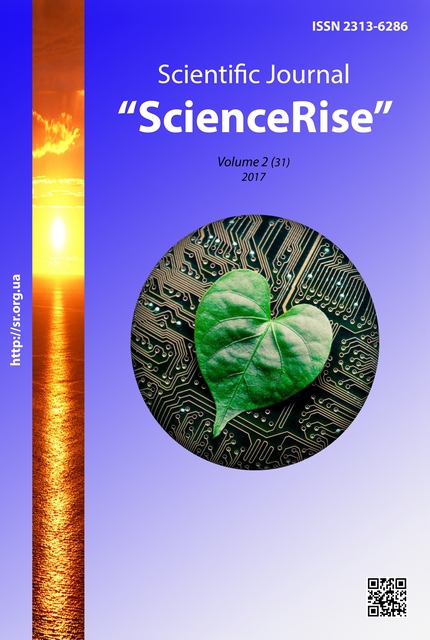Оценка точности прогнозирования коэффициентов трения многокомпонентных композиционных материалов
DOI :
https://doi.org/10.15587/2313-8416.2017.88681Mots-clés :
композиционный материал, прогнозирование, коэффициент трения, триботехнические характеристики, давление, пористость, скорость скольженияRésumé
Разработана методика прогнозирования коэффициентов трения многокомпонентных композиционных материалов. Представлены расчетные и экспериментальные значения триботехнических характеристик углерод – алюминиевых, металло-керамических и бронз-фторопластовых композиционных материалов. Установлено максимальное отклонение расчетных и экспериментальных значений коэффициентов трения, которое составляет 12 %
Références
Koltsova, Ya. I. (2001). Glassceramic materials of trubotrechnical setting on base of carbide of silicon. Ukrainian State University of Chemical Technology. Dnipropetrovsk, 19.
Petrova, P. N. (2002). Development of machine-building trubotrechnical materials on base polytetrafluorineethylene and natural materials on base zeolites of Yakut deposits. Yakutsk, 168.
Fratsevich, I. N., Karpinos, D. M., Tuchinskij, L. I., Kolesnichenko, L. F., Juga, A. I., Sapozhnikov, A. B., Vishnjakov, L. R. (1978). Anti-friction compositions on base sintered titanium. Powder metallurgy, 1, 61–65.
Nenachov, A. V., Kostornov, A. G. (2003). Trubotrechnical characteristics of materials on base bronze for small knots of friction. Powder metallurgy, 7 (8), 60–64.
Naldich, Yu. V., Kostornov, A. G., Adamovskij, A. A., Varchenko, V. T., Kostenko, A. D. (2011). Trubotrechnical properties superhard materials on base of boron nitride in contact with hart. Powder metallurgy, 5 (6), 105–112.
Burya, A. I., Arlamova, N. T., Burya, A. A., Il'jushenok, V. V., Cherskij, I. N. (1997). Research of operating characteristics of littlegap–filling phenylon. Friction and wear, 18 (5), 655–662.
Slachkov, V. A., Ivanov, V. I. (2007). Microstructure going to prognostication trubotechnical characteristics many-component composites. Samara: STU, 3, 472–473.
Samarskij, А. А., Michajlov, A. G. (2001). Mathematical modeling: Ideas Methods. Examples. Moscow: PhysMathLit, 320.
Majer, R. V. (2009). Computer modeling of the physical phenomena. Glazov: GSPI, 112.
Skachkov, V. A., Ivanov, V. I., Pechennikova, V. M. (2010). Research of process wear of friction products on base composites. Science in informative spoase. Dnepropetrovsk: DSABaА, 1, 87–89.
Nikitin, Yu. A., Zaporozhets, V. V. (2008). Technological aspects of creation lightweight composite materials for aerospace applications. Problems of friction and wear. Kyiv, 50, 149–156.
Axén, N., Hutchings, I. M. (1996). Analysis of abrasive wear and friction behaviour of composites. Materials Science and Technology, 12 (9), 757–765. doi: 10.1179/026708396790122413
Bogachev, I. N., Vajnshtejn, A. A., Volkov, S. D. (1972). Entry in statistical physical metallurgy. Moscow: Metallurgy, 216
Volkov, S. D., Stavrov, V. P. (1978). Statistical mechanics of composite materials. Мinsk: BSU, 208.
Téléchargements
Publié-e
Numéro
Rubrique
Licence
(c) Tous droits réservés Виктор Алексеевич Скачков, Ольга Руслановна Бережная, Оксана Сергеевна Воденникова 2016

Cette œuvre est sous licence Creative Commons Attribution 4.0 International.
Our journal abides by the Creative Commons CC BY copyright rights and permissions for open access journals.
Authors, who are published in this journal, agree to the following conditions:
1. The authors reserve the right to authorship of the work and pass the first publication right of this work to the journal under the terms of a Creative Commons CC BY, which allows others to freely distribute the published research with the obligatory reference to the authors of the original work and the first publication of the work in this journal.
2. The authors have the right to conclude separate supplement agreements that relate to non-exclusive work distribution in the form in which it has been published by the journal (for example, to upload the work to the online storage of the journal or publish it as part of a monograph), provided that the reference to the first publication of the work in this journal is included.

